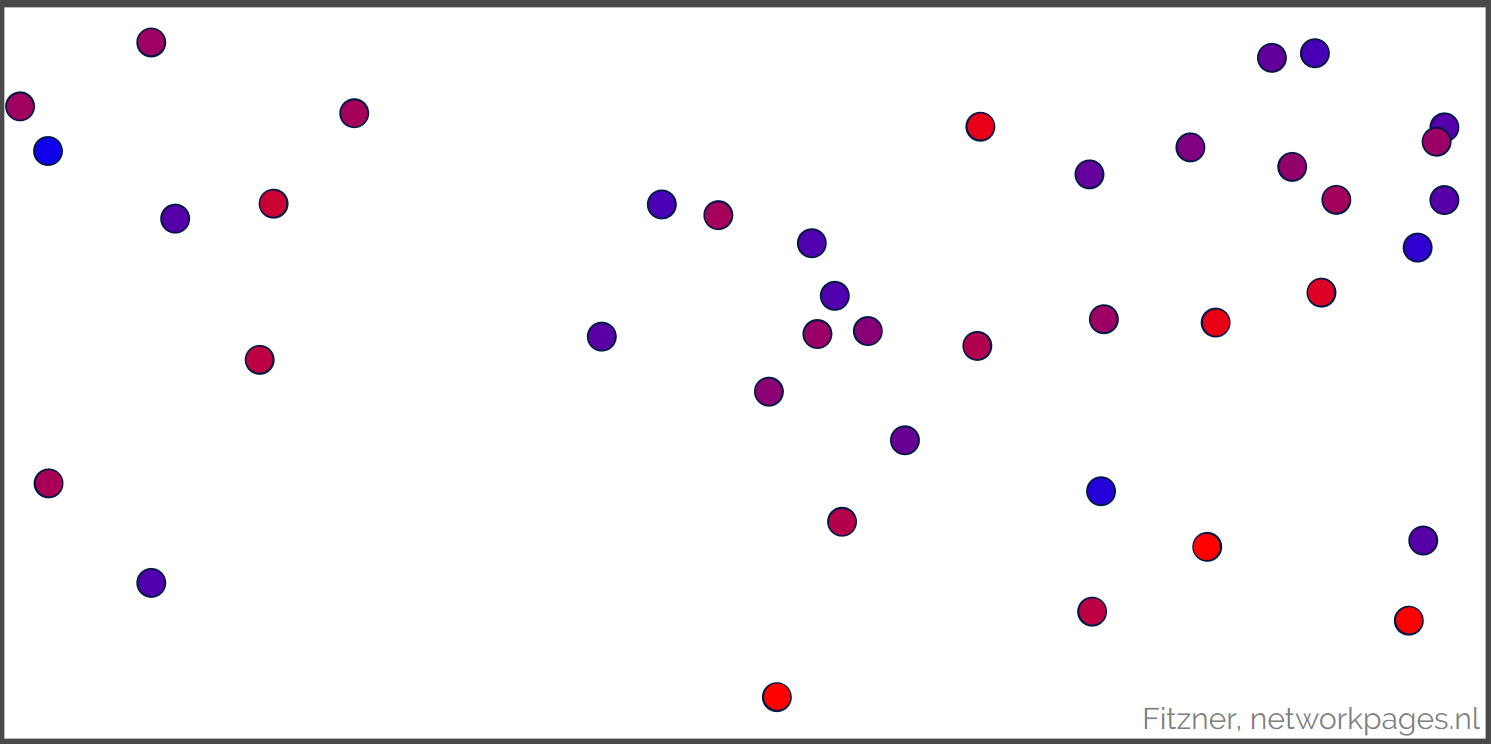Interacting particle systems
Statistical physics aims at describing collective behaviour in systems consisting of a very large number of interacting particles (= atoms or molecules). This is a daunting task: a glass of water or a piece of iron can easily contain
100.000.000.000.000.000.000.000 particles.
Still, the hope is that the macroscopic properties of these particles as a whole can be explained from the microscopic interactions between them. For instance, we want to explain why water turns into ice (or vapour) at an appropriate temperature and how this transition exactly takes place. Similarly, we want to explain why a piece of iron at low temperature becomes magnetised when it is moved close to a magnet and remains magnetised after it is moved away from the magnet. We also want to understand why this does not happen when the temperature is high. For most physical systems the trajectories of the particles are so chaotic that they cannot be captured by explicit formulas. A full description would require knowledge of the positions and the speeds of all the particles at all times, which clearly is hopeless. Yet, we need large numbers of particles to explain collective phenomena: a single water molecule cannot transit from water to ice (or vapour). So how should we go about?
The way out of this dilemma is offered by statistical physics: for most purposes a full microscopic description is not necessary: it suffices to have a macroscopic description in terms of a small number of relevant quantities, such as pressure, density and temperature. In statistical physics, the system is assumed to be a random sample, drawn from a set of allowed microscopic configurations that are consistent with a set of given macroscopic constraints. These constraints determine the pressure, density and temperature of the system. Collective phenomena, such as whether the system is a solid (ice), a liquid (water) or a gas (vapour), should follow from a combination of the microscopic interactions and the macroscopic constraints.
A physical system is rarely isolated. Typically, it is part of a larger system, that in turn is part of an even larger system, etc. For example, the molecules in a glass of water depend on what is outside the glass. The molecules at the top of the glass interact with the air above it. This air also contains water molecules, and a lively exchange takes place close to the surface of the water. We are thus tempted to believe that, in order to understand what happens inside the glass of water, we need to model all the molecules around the glass as well, and perhaps even all the molecules in the room the glass finds itself in. Fortunately, this is not the case, since the water molecules can only interact over short distances.
Statistical physics deals with the definition of the appropriate probability distribution over the set of allowed microscopic configuration, such as the locations and the speeds of the particles and how they bounce off each other and the wall of the container. These distributions need to take the macroscopic constraints into account. For instance, when the temperature is high the particles move quickly, which should be reflected in the choice of the probability distribution for the positions and the speeds. There are three main choices of probability distribution, referred to in statistical physics as ensembles, each describing how the system interacts with its surroundings. Each represents a different physical situation.
- The micro-canonical ensemble, where hard constraints are placed on both the energy and the number of particles: both are set to fixed values and are not allowed to vary.
- The canonical ensemble, where a soft constraint is placed on the energy of the particles (in the sense that it may vary but with a fixed average), while a hard constraint is placed
on the number of particles. - The grand-canonical ensemble, where both the energy and the number of particles are soft.
For systems of infinite size, the three ensembles lead to different results. Therefore, in practical situations, the choice of ensemble is important and must be based on the physical situation that is described. In particular, an experimental physicist would use ensemble
- to model an isolated system (= a system that exchanges neither heat nor particles with its surroundings).
- to model a closed system (= a system that exchanges heat with an "external reservoir", with which it is in thermal equilibrium, but no particles).
- to model an open system (= a system that exchanges both heat and particles with the external ereservoir, with which it is in thermal and chemical equilibrium).
Choosing the wrong ensemble amounts to choosing the wrong microscopic probability distribution on which the computation of macroscopic quantities is based. For instance, if the experimental physicist is certain that the system under study does not exchange particles with its surroundings, then ensemble 3 is clearly not the right choice, and it would make the microscopic description of the system more noisy than is necessary.
What happens when the system is very large? Traditionally, in physics books the three ensembles are assumed to be thermodynamically equivalent: for large systems fluctuations of macroscopic quantities around their average value are expected to be small and to be asymptotically vanishing as the number of particles tends to infinity. In the latter limit, called the thermodynamic limit, the soft constraints effectively become hard constraints. The assumption of ensemble equivalence dates back to Gibbs [1] and has been verified for traditional models of physical systems with short-range microscopic interactions and subject to a small number of macroscopic constraints. Ensemble equivalence is convenient because it allows us to choose any of the three ensembles to work with. Soft constraints often are computationally easier to work with than hard constraints, which makes the choice of ensembles 2 and 3 more convenient than that of ensemble 1. If ensemble equivalence holds and the system is large enough, then all three ensembles lead to the same outcome.
However, ensemble equivalence does not hold in general. This fact is important because it means that an experimental physicist must make a careful choice what ensemble to use for modelling the system, even when the system is large. A wrong choice means a wrong answer to macroscopic questions. Despite the fact that many textbooks still convey the message that ensemble equivalence holds for all physical systems (as some sort of universal thermodynamic property), over the last decades various examples of physical systems have been found for which it breaks down. Touchette [2] offers insight into why this breakdown may happen.
References
[1] J.W. Gibbs, Elementary Principles of Statistical Mechanics, Yale University Press, New Haven, Connecticut (1902).
[2] H. Touchette, Journal of Statistical Physics, volume 159, page 987 (2015).






